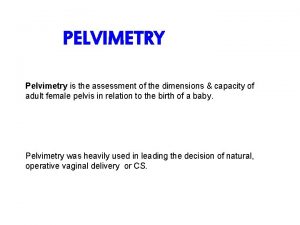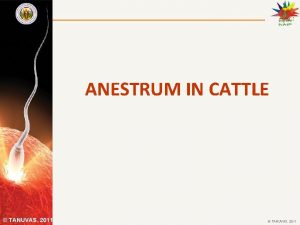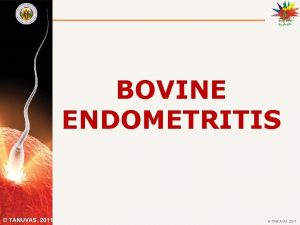VGO 421 TANUVAS 2011 PELVIMETRY TANUVAS 2011 The
































- Slides: 32

VGO 421 © TANUVAS 2011 PELVIMETRY © TANUVAS 2011

The bony structures of the pelvis is comprised of VGO 421 © TANUVAS 2011 – Sacrum – First to third coccygeal vertebra, and – The two os coxae, each formed by the • Ilium • Ischium, and • Pubis. © TANUVAS 2011

VGO 421 Sacrum • In cow, sacrum is formed by the fusion of five vertebrae. • In older cow, horse and pig, the first coccygeal vertebra may fuse with the sacrum. Ilium • Irregularly triangular in shape. • Broad, flat, dorsal part of the ilium is referred to as the Wing. • The external portion of the wing of the ilium is referred to as the tuber coxae, hip bone, or “HOOK” bone. © TANUVAS 2011

VGO 421 © TANUVAS 2011

VGO 421 © TANUVAS 2011 Ischium • Forms the caudal part of the ventral floor of the pelvis. • Caudal lateral portion of these bones are referred to as tuber ischii or “PIN” bones. • In pig, tuber ischii are largely cartilaginous and complete ankylosis of the symphysis does not occur until 6 -7 years of age. • In sow and cow, ischiatic spines are prominent. • Pelvic symphysis is formed by the medial fusion of ischial and pubic bones. • In cow and ewe, the portion of the pelvic floor formed by the two ischial is deeply concave from side to side. © TANUVAS 2011

VGO 421 © TANUVAS 2011

VGO 421 © TANUVAS 2011 Pubis • Smallest bone of the os coxae and forms the cranial portion of the pelvic floor. • Pelvic surface is smooth – In females: concave – In males: convex • In young cows, on the cranial portion of the pubic symphysis, occasionally a sharp tuberosity projects and may rarely result in contusion or laceration of the birth canal during dystocia. Acetabulum • Formed by the fusion of ilium, ischium and pubis. • These bones form a cotyloid cavity for lodging the head of the femur. © TANUVAS 2011

PELVIC LIGAMENTS VGO 421 • Form the non-bony part of the pelvis. • To maintain the relationship of the pelvis to the spinal column, there are three, single or paired, pelvic ligaments. 1. Dorsal and lateral sacroiliac ligaments – attached to the medial wing of the ilium and lateral portion of the sacrum and the summits of the sacral spines © TANUVAS 2011

2. SACROSCIATIC LIGAMENTS VGO 421 © TANUVAS 2011 • An extensive quadrilateral ligamentous sheet that completes the lateral wall of the pelvic cavity. • Extends from the lateral border of the sacrum and the transverse processes of the first coccygeal vertebrae to the ischiatic spine and tuber ischii. • Provides attachment for large gluteal muscles and the vulva. • In dog, this ligament is referred to as sacro-tuberous ligament. © TANUVAS 2011

VGO 421 3. Prepubic tendon is essentially the tendon of insertion of recti abdominis muscle and others, except the transverse abdominis muscle. It is attached strongly to the cranial medial border of the pubic bones. Significance: Fixing the sacro-iliac articulation and maintaining the bony pelvis in proper position. © TANUVAS 2011

PELVIC CAVITY Cone shaped with the base of the cone located cranially. VGO 421 Base is formed by bony pelvis. Size of the pelvic inlet varies greatly within species due to breed, age and size. SHAPE AND BIOMETRY OF BONY PELVIS Species © TANUVAS 2011 Shape of pelvic inlet Sacro-pubic Bisiliac Cow Elliptical (Cm) 19. 0 – 24. 1 (Cm) 14. 6 – 19. 0 Mare Round 20. 3 – 25. 4 19. 0 – 24. 1 Sheep Elliptical 7. 6 – 10. 8 5. 7 – 8. 9 Sow Elliptical 9. 5 – 15. 2 6. 3 – 10. 2 Bitch Round 3. 3 – 6. 3 2. 8 – 5. 7 © TANUVAS 2011

Pelvices of domestic animals VGO 421 © TANUVAS 2011

PELVIMETRY VGO 421 Is the technique of measuring the dimensions of the osseous pelvis from which the approximate pelvic area is calculated. © TANUVAS 2011

INTRODUCTION VGO 421 • In human obstetrics, pelvimetry has been a routine part of the prenatal management • Little attention in veterinary obstetrics until the last decade. • In the recent years there is a great deal of interest shown in this area and the information gained will help one to reduce the incidence of dystocia. © TANUVAS 2011

INDICATIONS VGO 421 • To select heifers at the time of joining breeding programme. • Pregnancy testing for dystocia-free calving. • To predict a possible dystocia due to feto-pelvic disproportion. © TANUVAS 2011

METHODS VGO 421 External or indirect pelvimetry is carried out by calculating the pelvic diameter based on measurements taken between the angles of the ilia, the distance between the ischia and the height from the hip joint to highest point of the croup. In general, this method has been shown to be inaccurate and is no longer used. Internal or direct pelvimetry refers to the measurement of the interior of the pelvis through the rectum with a pelvimeter. © TANUVAS 2011

MATERIALS AND RESTRAINT VGO 421 Materials • A hinged or sliding graduated pelvic caliper. • Obstetrical lubricant or non-irritant soap, bucket of clean water with disinfectant. • Full arm rubber or disposable gloves. • Paper and pen for recording the observations. Restraint • Animal should be restrained in a trevis or chute to prevent sideways movement. © TANUVAS 2011

VGO 421 Designed by DR. S. BALASUBRAMANIAN Dr. D. KATHIRESAN Dr. S. A. ASOKAN © TANUVAS 2011

EXTERNAL PELVIMETRY VGO 421 This is arrived at by determining the diameters of pelvis from certain body measurements. The following external pelvic measurements are taken Distance between the external angle of the ilium (cm) : A Distance between the ischial tuberosity (cm) : B Distance between the summit of the croup and the hip joint : C (cm) © TANUVAS 2011

Distance between the external angle of the ilium (cm) : A VGO 421 © TANUVAS 2011

VGO 421 © TANUVAS 2011 Distance between the ischial tuberosity (cm) : B © TANUVAS 2011

Distance between the summit of the croup and the hip VGO 421 © TANUVAS 2011 joint (cm) : C © TANUVAS 2011

Based on the measurements the pelvic area is calculated as follows VGO 421 S. No. © TANUVAS 2011 Measurement Formula 1. Transverse diameter of pelvic : outlet 2. Vertical diameter of pelvic outlet 3. Transverse diameter of pelvic : 12. 2/10 x (Transverse diameter inlet of pelvic outlet) 4. Vertical diameter of pelvic inlet : : ¼ (A+B) ¾x. C 13/10 x (vertical diameter of pelvic outlet). © TANUVAS 2011

INTERNAL PELVIMETRY VGO 421 • This is done by direct manual examination of the interior of pelvis on rectal and vaginal examination. • The distances between various parts of the pelvis can be approximately determined by calibrating the palm. © TANUVAS 2011

RICE PELVIMETER VGO 421 © TANUVAS 2011

GENERAL PROCEDURE • Restrain the animal in a chute with light squeeze. • A comfortable normal standing position is best. VGO 421 • Feces should be removed from the rectum and the caliper carefully carried into the rectum with the hand arm to the pelvic inlet. • The width of the pelvic inlet is obtained at its widest point between the right and left shafts of the ilium. This is the horizontal (bisiliac) diameter of the pelvis. • The height of the pelvic inlet is obtained by measuring the distance between the dorsal pubic tubercle on the floor of the pelvic and the sacrum, dorsal. This is the vertical (sacro-pubic) diameter of the pelvis. © TANUVAS 2011

CALCULATION VGO 421 • The two measurements are read in centimeters and are multiplied to give the pelvic area in square centimeters. • Alternatively, an adjustment can be made for the elliptical shape of the anterior pelvic opening using the formula: V x Tx π /4. Either method gives a relative figure which, when correctly interpreted, may provide useful information. © TANUVAS 2011

PELVIC INLET VGO 421 © TANUVAS 2011

RICE PELVIMETER VGO 421 VERTICAL DIAMETER © TANUVAS 2011

RICE PELVIMETER VGO 421 HORIZONTAL DIAMETER © TANUVAS 2011

krautmann PELVIMETER VGO 421 VERTICAL DIAMETER © TANUVAS 2011

krautmann PELVIMETER VGO 421 HORIZONTAL DIAMETER © TANUVAS 2011
 Ectomy a suffix denoting an excision or removal
Ectomy a suffix denoting an excision or removal Pelvic outlet
Pelvic outlet Tanuvas vice chancellor
Tanuvas vice chancellor Repeat breeding tanuvas
Repeat breeding tanuvas Cmsc 421 umbc
Cmsc 421 umbc Fwm 421
Fwm 421 421 rule
421 rule Epl421
Epl421 Single pass tubular heater
Single pass tubular heater Ist 421
Ist 421 Cse 421
Cse 421 Estimated blood volume
Estimated blood volume Psy
Psy Ist 421
Ist 421 Sql integrity constraints
Sql integrity constraints Fwm 421
Fwm 421 Aae 421
Aae 421 Aae 421
Aae 421 Ist 421
Ist 421 Steam heat exchanger design
Steam heat exchanger design Comp 421
Comp 421 Comp 421
Comp 421 421 rule maintenance fluids
421 rule maintenance fluids Cs 421 uiuc
Cs 421 uiuc Epl421
Epl421 421 could not create socket
421 could not create socket Ist 421
Ist 421 Business process integration tools
Business process integration tools Steps for application integration
Steps for application integration Ist 421
Ist 421 Here is where your presentation begins
Here is where your presentation begins Advanced systems integration
Advanced systems integration Cmsc 421
Cmsc 421





















































